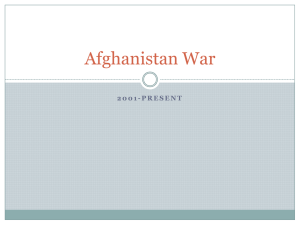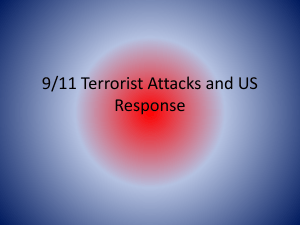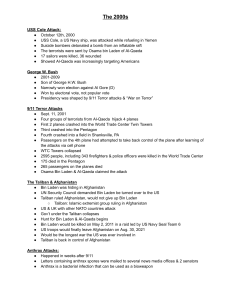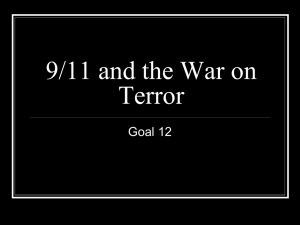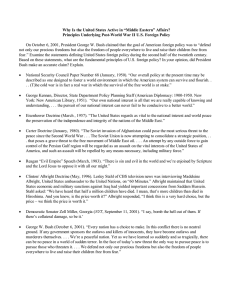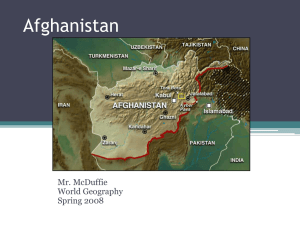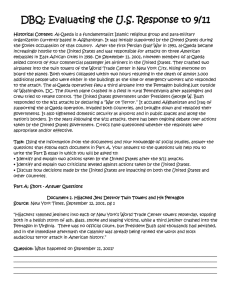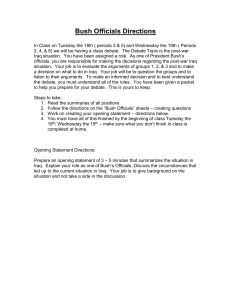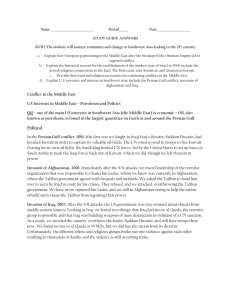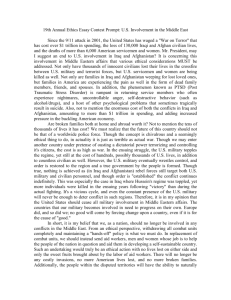How Sept. 11, 2001 Changed America
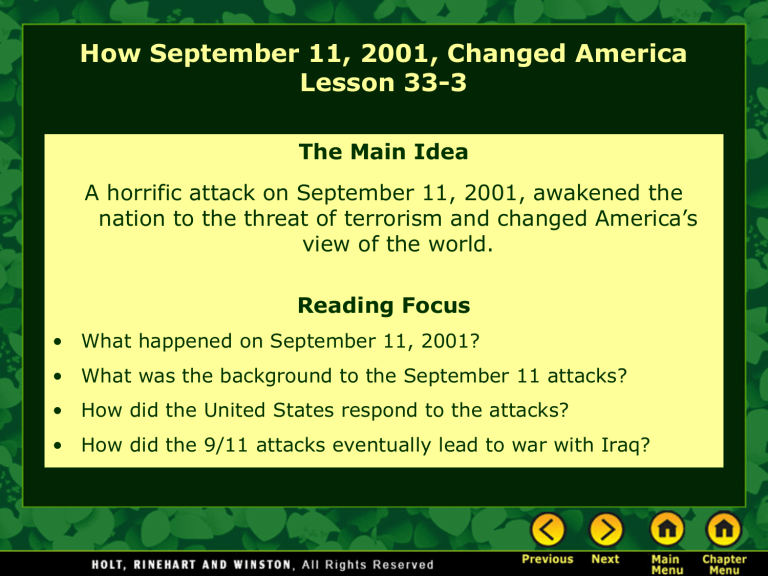
How September 11, 2001, Changed America
Lesson 33-3
The Main Idea
A horrific attack on September 11, 2001, awakened the nation to the threat of terrorism and changed America’s view of the world.
Reading Focus
• What happened on September 11, 2001?
• What was the background to the September 11 attacks?
• How did the United States respond to the attacks?
• How did the 9/11 attacks eventually lead to war with Iraq?
September 11, 2001
A Deliberate Attack
• Terrorists hijack two planes—
American Airlines Flight 11 and United Airlines flight
175—and crash them into the
World Trade Center.
• Terrorists hijack American
Airlines Flight 77 and crash it into the Pentagon.
• Terrorists hijack United
Airlines Flight 93, which crashes in southwestern
Pennsylvania.
• In New York and Virginia, firefighters and police officers rush to the scene of the attacks.
The Twin Towers Collapse
• Both the South and the North
Towers of the World Trade
Center collapsed.
• Fires caused by the planes full fuel tanks weakened the buildings’ structures.
• A stunned nation watches these events unfold on television.
September 11, 2001
The Death Toll
• All 265 people on the four airplanes were killed.
• Estimates of the deaths at the World Trade Center were in the thousands.
• After years of investigations, the New
York death toll stood at
2,749.
• 125 people died in the attack on the Pentagon.
The Nation Reacts
• People were sad and angry.
• Many admired New York’s firefighters and mayor,
Rudolph Giuliani.
• Americans reached out to the victims, donating blood and money.
• Rescue workers from around the country traveled to New York to help at Ground Zero.
Background to the September 11 Attacks
• Osama bin Laden and his terrorist network, known as al Qaeda, planned and carried out the attacks.
• Bin Laden wanted to promote a worldwide
Islamic revolution.
• He claimed this required the destruction of the
United States.
• Al Qaeda terrorists began entering the United
States in 2000 and were ready for the attack by
September 11, 2001.
Background to the Attacks
Osama bin Laden
• Member of a wealthy Saudi
Arabian family
• Wanted to start a worldwide
Islamic revolution
• Angry at the presence of
American military in Saudi
Arabia during the Gulf War
• Developed a terrorist network called al Qaeda, or “the base”
• Had links to a 1993 bombing at the World Trade Center
• Trained attackers that killed
American soldiers in Somalia
Al Qaeda
• Made a number of threats against the United States
• Connected to the bombings of the U.S. embassies in Kenya and Tanzania
• Clinton launched a missile attack into an al Qaeda training camp in Afghanistan.
• Carried out a bomb attack against the USS Cole
• Terrorists entered the United
States in 2000 and enrolled in flight schools to learn to fly airplanes.
How did the United States respond to the attacks?
War in Afghanistan
• A group known as the
Taliban ruled in Afghanistan.
• Governed according to strict
Islamic law
• Close relationship with bin
Laden
• Bush demanded that the
Taliban seize bin Laden and give him to the United States.
• The Taliban refused and so on October 7, 2001, the
United States and Great
Britain attacked the Taliban in
Afghanistan.
Results of the War
• U.S. and British troops relied on fighters of Afghanistan’s
Northern Alliance—a group that opposed the Taliban.
• The Taliban was defeated by early December.
• Bin Laden, however, managed to avoid being captured.
Fighting Terrorism at Home
Bush and Congress created the Department of Homeland
Security.
After 9/11 the nation experienced another type of terrorist threat: deliberate anthrax poisoning.
The crisis was limited to a handful of specific locations, but it alarmed the American people.
The White House proposed the USA PATRIOT Act, which made it easier for law enforcement to secretly collect information about suspected terrorists.
Critics claimed this act gave law enforcement too much power and posed a threat to basic freedoms.
War in Iraq
• Bush declared a war on terror and listed Iraq as a possible foe.
• Iraq was to destroy its weapons of mass destruction after the Gulf War and allow UN weapons inspectors inside the country.
• Although Iraq allowed weapons inspections following 9/11,
Bush insisted that Iraq had failed to account for weapons it was known to have possessed after the Persian Gulf
War.
• Many of America’s longtime allies advised against going to war, but Bush insisted that Iraq was a threat and invaded
Iraq in March 2003.
Results of the Iraqi War
• Within a month, Saddam’s regime fell and
Saddam was captured within the year.
• American forces remained in Iraq to help keep order and train a new Iraqi security force.
• Terrorists continued to take a terrible toll on
American soldiers and Iraqi citizens.
• Bush faced criticism when no weapons of mass destruction were found.
• However, he was re-elected and made clear that U.S. forces would remain in Iraq for as long as necessary to ensure peace and order there.
Click on the window to start video
